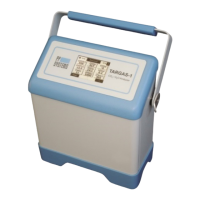TARGAS-1 Operation Manual V. 1.02 85 support@ppsystems.com
Maximum time for which changes in the chamber CO
2
monitored in a given session. This value is defined in CPY – Termination
Stops the CPY process and returns to CPY – Other Settings (Step 4).
Only the individual CO2 measurements are saved to the USB flash
drive. Process data is discarded.
Stops the CPY process and returns to CPY – Other Settings (Step 4).
Results are saved to the USB flash drive.
The measurement sequence will terminate when the maxDC or maxDT is reached. If maxDT is reached
first, the message “Time limit” will appear in the status box. If maxDC is reached first, the message “CO2
limit” will appear in the status box.
For more information on the theory and calculation of soil
respiration/canopy assimilation, please refer to Mass Flow
Calculate the mass flow of air (W) entering the cuvette per unit leaf area
(A.1) The TARGAS-1 mass flowmeter is calibrated to read the volume flow (V
) at 0 °C and 1013.25 mb
(STP). The Ideal Gas molar volume is 22.414 L mol
-1
at STP. Therefore:
W
(
mol m
‐
s
‐
)
=
V
60 × 10
×
1
22.414
×
10
a
where:
a = projected leaf area (measured in cm
2
converted above to m
2
)
V
= volume flow (measured in cc min
-1
converted above to L sec
-1
)
Note that W and all subsequent equations are presented as quantities per unit leaf area. The projected
leaf area is an input to the TARGAS-1 software to correctly compute gas exchange results. The PLC5
window area is 4.5 cm
2
, and this is the default leaf area used in calculations. However, if measurements
are made with leaves that don't completely fill the window, the actual Leaf Area should be entered in
Measure Screen 2 prior to making measurements. Alternately, if the Leaf Area is not known at the time of
measurements, PP Systems provides a simple TARGAS-1 Excel
®
spreadsheet program that allows
recalculation of all gas exchange results with different Leaf Area.
Transpiration
Calculate transpiration rate (E) from the partial pressures of water vapor of the air entering (e
) and
exiting (e
) the cuvette
(A.2) The molar flow of water vapor (mol m
2
s
-1
) into the cuvette is:
W ×
e
P
(A.3) The molar flow of air out of the cuvette (with the addition of transpired water vapor) is (W + E).
Therefore, the molar flow of water vapor out of the cuvette is:

